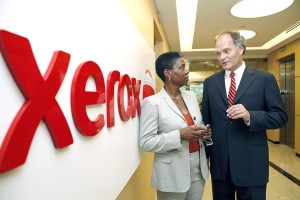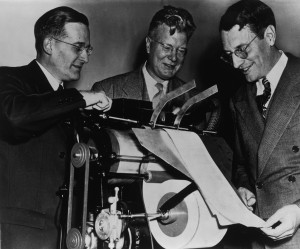The following appears on westfaironline.com
Several months ago, Xerox Corp. launched a campaign that aims to dispel its reputation as just a brand of copy machines.
While most people still imagine printers and paper products when they hear the name Xerox, the Norwalk-based company has for years been shifting its emphasis toward business services. For example, every year Xerox processes 1.4 billion EZPass toll transactions and 563 million government health program claims.
“Companies depend on today’s Xerox for services that simplify how work gets done,” one advertisement states. “Which is pretty much everything we’ve always stood for.”
While Xerox contends its mission hasn’t changed, its principle source of revenue has.
Xerox has made a concerted push toward services as it phases out its traditional document management units, highlighted by the company’s $6.4 billion acquisition of ACS Inc. Xerox CEO Ursula Burns, left, with former ACS CEO Lynn Blodgett.
Today 55 percent of Xerox’s revenues come from the company’s services units, as opposed to its document technologies, which are slowly being phased out.
For 2012, the company reported an 11 percent decrease in net income and a 1 percent decrease in total revenue, year over year. During the first quarter of 2013 — after the company revealed plans to lay off about 2 percent of its workforce — it reported a 10 percent increase in net income and a 3 percent decrease in total revenue.
The bulk of the decline in revenue during the first quarter came from a 9 percent decrease within the document technology segment, which was more than was expected, said Karen Arena, Xerox vice president of communications.
After the company refreshed its mid-range document technology segment, there was less of a financial benefit, Arena said.
But it’s also a signal of the company’s evolving structure. In the early 2000s Xerox began creating digital document management systems and in fall 2009 it agreed to acquire Affiliated Computer Services (ACS) Inc., a “giant” in business processes and IT outsourcing services, for $6.4 billion, Arena said.
“Our eyes were wide open to the upcoming trends — seeing that technology was enabling people to work differently, to be more mobile and need physical paper less,” Arena said.
By 2017, Xerox expects the services sector to make up two-thirds of its revenues, allowing for more profitable margins. However analysts have said Xerox faces stiff competition from other companies in the industry, such as NCR Corp. and Concurrent Computer Corp.
Chester Carlson,
center, demonstrates early xerographic printing technology, which he invented
in 1938.
The company’s second quarter earnings report is due out July 25.
“Since the acquisition of ACS, we have a laser focus on managing our clients’ work processes that are not core, yet important to their business, like claims processing, finance and accounting and HR functions to name a few,” Arena said. “From our earliest days, our purpose was never about making copying and printing equipment, but rather to make it easier to share information. Making things simpler has always been and is still in our DNA.”
Every day Xerox handles more than 1.6 million customer service calls in more than 30 languages in 175 global call centers. The company also provides services to more than 1,700 federal and municipal government entities.
Click here to read the rest of the article on westfaironline.com

